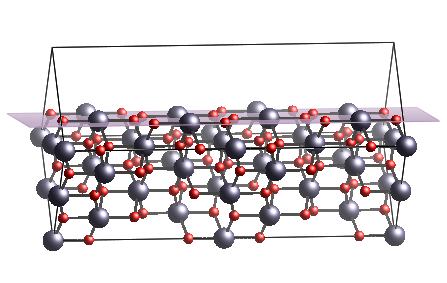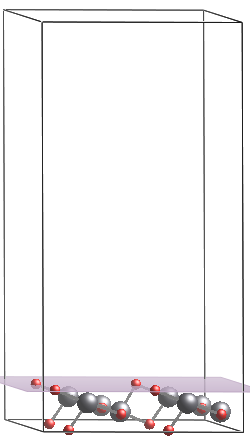The are several phenomenoms: catalisis, adsorption, molecule degradation (lysis),
or CO oxidation, that takes place on the surface solid. As volume is an infinite
periodic slab, there are not boundaries, so it is important to study the different
surfaces that a crystal may have. Because periodicity is broken, the surface has
to relax itself to a minimum structure, it may be possible a re-structuration on
its geometry.
To build a crystal slab, is not as easy as it may appear, there are several GUI
programs that can help us to construct the slab, such as:
VESTA,
Schakal,
MS modelling,
Virtual NanoLab, among others.
Each program has its own methodology, some of them involves a deeply understand on
crystal symmetries and algebra operations.

Figure 1. Titanium Dioxide surface [110], the purple plane indicates the surface. Made it on VESTA .
Surface Relaxation
Lets relax the anatase [101], with a supercell of 2x2 and a 3 layer deep as it is shown in figure 2.

Figure 1. A 3 Layer Titanium Dioxide surface [101], the purple plane indicates the surface. Made it on VESTA .
Anatase 2x2 3 layer ion relaxation
1
11.15240 0.00000 0.00000
-2.59202 7.14815 0.00000
0.00000 0.00000 22.9027
Ti O
8 16
Direct
0.473363012 0.463707000 0.035668001
0.239115998 0.096606001 0.067971997
0.973362982 0.463707000 0.035668001
0.739116013 0.096606001 0.067971997
0.473363012 0.963707983 0.035668001
0.239115998 0.596606016 0.067971997
0.973362982 0.963707983 0.035668001
0.739116013 0.596606016 0.067971997
0.283683002 0.368804991 0.064138003
0.060327001 0.007208000 0.101410002
0.425368994 0.189715996 0.037709001
0.134815007 0.044450000 0.002996000
0.783683002 0.368804991 0.064138003
0.560326993 0.007208000 0.101410002
0.925369024 0.189715996 0.037709001
0.634814978 0.044450000 0.002996000
0.283683002 0.868804991 0.064138003
0.060327001 0.507207990 0.101410002
0.425368994 0.689715981 0.037709001
0.134815007 0.544449985 0.002996000
0.783683002 0.868804991 0.064138003
0.560326993 0.507207990 0.101410002
0.925369024 0.689715981 0.037709001
0.634814978 0.544449985 0.002996000
INCAR preparation
In this example we are going to relax the ion possition in the cell, because symmetry is broken and the number of atoms increase, VASP will take more ion relaxation steps, so be patient. The INCAR file must have the followin directives.
- ISTART= 0 New Job.- ISIF = 2 Ions relaxation.
- IBRION= 2 DFT Conjugate Gradient.
- NSW = 55 Maximum Optimization steps.
- EDIFF & EDIFFG Convergence Criteria.
# Anatase Surface Relaxation #=========================================== # General Setup System = Anatase # Calculation Title PREC = NORMAL # Options: Normal, Medium, High, Low ENCUT = 400 # Kinetic Energy Cutoff in eV ISTART = 0 # Job: 0-new 1-cont 2-samecut ICHARG = 2 # initial charge density: 1-file 2-atom 10-cons 11-DOS ISPIN = 1 # Spin Polarize: 1-No 2-Yes # Electronic Relaxation (SCF) NELM = 60 # Max Number of Elec Self Cons Steps NELMIN = 2 # Min Number of ESC steps NELMDL = 10 # Number of non-SC at the beginning EDIFF = 1.0E-04 # Stopping criteria for ESC LREAL = .TRUE. # Real space projection IALGO = 48 # Electronic algorithm minimization VOSKOWN = 1 # 1- uses VWN exact correlation ADDGRID = .TRUE. # Improve the grid accuracy # Ionic Relaxation EDIFFG = -1.0E-03 # Stopping criteria for ionic self cons steps NSW = 55 # Max Number of ISC steps: 0- Single Point IBRION = 2 # Ionic Relaxation Method: 0-MD 1-qNewton-RaphsonElectronic 2-CG ISIF = 2 # Stress and Relaxation: 2-Ion 3-cell+ion ADDGRID = .TRUE. # Improve the grid accuracy SIGMA = 0.10 # Insulators/semiconductors=0.1 metals=0.05 ISMEAR = 0 # Partial Occupancies for each Orbital # -5 DOS, -2 from file, -1 Fermi Smear, 0 Gaussian Smear # Parallelization NPAR=8 # NCORE=1 #Search the NCORE of your system NSIM = 4
POTCAR
We have to combine the potential files of Ti and O. To do that copy the POTCAR files into your work directory with diferent name. Potential files are in the directory where you install VASP. Finally just concatenate both files into a new file called POTCAR. Remember conserve the order that we impose in the POSCAR.
[user@machine WRKDIR]$ cp ~/VASP/vasp5.x/Potential/PBE/Ti_sv/POTCAR POTCAR_Ti
[user@machine WRKDIR]$ cp ~/VASP/vasp5.x/Potential/PBE/O/POTCAR POTCAR_O
[user@machine WRKDIR]$ cat POTCAR_Ti POTCAR_O >> POTCAR
KPOINTS file
We are going to generate an automatic K-mesh with 64 K-points distributed in all directions.
Automatic Mesh # Generates Automatically the K-mesh 0 Monkhorst-pack # Automatic Distribution of the mesh 8 8 1
Due that there is no periodicity on the Z axis, there is only one KPOINT on Z.
Job administrator
If you have a queue administrator you have to set the queue file. FamaLab has torque as default job manager. Please paste the queue file .pbs or .sge into your work directory.
The file has as main directives the jobname, the number of cpu you are requesting, the time is going to take your calculation, and which of the vasp programs you will use.
#PBS -N name_identifier #PBS -o vasp.out #PBS -j oe #PBS -e vasp.err #PBS -l walltime=8760:00:00 #PBS -l nodes=1:ppn=8 #PBS -q batch #Elegir la version de vasp: VASP=vasp_cd #Volume=vasp_complex, supercell=vasp_cd, molecules=vasp_gamma
The variables you can modify are marked in red:
- Name identifier is the label on the queue of the jobs, it cannot start with a number.
- The ppn variable is the number of cores (cpu's) you specify on the INCAR.
- vasp_complex: is used when the system has all symmetries. For volume structures.
KPOINTS N N N
- vasp_cd: is for a systems which has only two periodic dimensions.
For surfaces. KPOINTS N N 1.
- vasp_gamma: is fot system with non periodicity. For molecules. KPOINTS N 1 1
You can download the build files here:
INCAR
POTCAR
KPOINTS
POSCAR